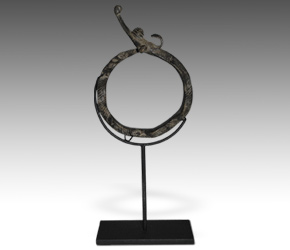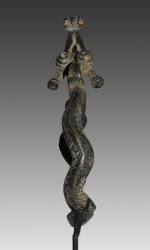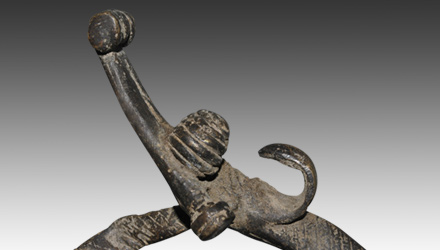Gan Bracelet Currency
 |
|
"To the Gan people, the python is the protector of the family and Gan culture, and a symbol of courage and fearlessness, historically worn by Gan warriors for protection. The Gan consider the python a divine snake, symbolically coiling itself around the earth to keep it firm"
In 1984, Upper Volta was renamed Burkina Faso, thus discarding the name the French had given their former colony. Burkina Faso is an artificial word, using linguistic elements from the country's largest languages: Burkina means “free man” in Mooré; Faso means “land” in Dyula. Burkina Faso is thus identified as the “country of the free men.” It is a multiethnic nation with about sixty ethnic and linguistic groups.
 |
|
For ethnologists, one particular group – the Gan – was essentially unknown until well into the 20th century. Gan works of art were often attributed to neighboring groups such as the Lobi or the Kulango from the Ivory Coast. Not until unusual pieces began appearing on the international art market were the Gan people given full credit for their work.
The Gan identity was difficult to establish because unlike other neighboring groups their origin cannot be established on the basis of their language, which is called kaasa. The kaasa language shows a clear relationship with the languages spoken by the nearby Senufo people. Consequently, ethnologists now believe they are related to the Senufo; a relationship further established by striking similarities in their artwork. However, unlike the Senufo and many other groups in the region, the Gan have retained a traditional system of leadership headed by a king, who is elected from the royal clan and rules for life. They still practice an animistic religion, which suggests a single, supreme creator animating all aspects of the environment with a group of nature spirits mediating in-between. Today, there are less than 6,000 native Gan people.
Many animals are depicted in Gan art work and jewelry, and these might be considered depictions of the nature spirits. Some examples include the chameleon, an animal both feared and worshipped, believed to be the bearer of ominous news; and the crocodile, especially revered because it remains in constant contact with water, the source of all life. Nonetheless, the representation of snakes, specifically the python, is the central theme in Gan metal art. Depictions of pythons are so prevalent, in fact, their appearance might at times be deemed obsessive.
In general, serpents enjoy a special position in African beliefs. They seem to have a relationship with spirits; they are inhabited by spirits or are spirits themselves, and consequently, they are regarded as messengers of the ancestors. In the Senufo pantheon they are considered a primordial creature and because they shed their skin is a symbol of rebirth. The Gan share all these beliefs, but the python has even more meaning for them. The python is considered a divine snake, symbolically coiling itself around the earth to keep it firm. It is the protector of the family and Gan culture, and a symbol of courage and fearlessness, historically worn by Gan warriors for protection. The python is also a tutelary symbol said to protect the royal family and the kingdom from forces such as obscurity, evil, and sorcery.
These beliefs are translated into Gan armbands, bracelets, amulets and other ritual objects, most often dedicated to the python. These pieces are often buried underground to protect them from prying eyes and potential looters; and occasionally, they are used in divinations. After remaining underground for a period of time they are unearthed and can be used to tell the health and potential death of individuals depending on their orientation. It is impossible to determine who wore this armband or if it was used as a divination tool since little is written about specific Gan rituals or ceremonies. However, it can be said with certainty this armband is a fine representation of Gan belief and art.
Download this Article: Gan Bracelet Currency.pdf
